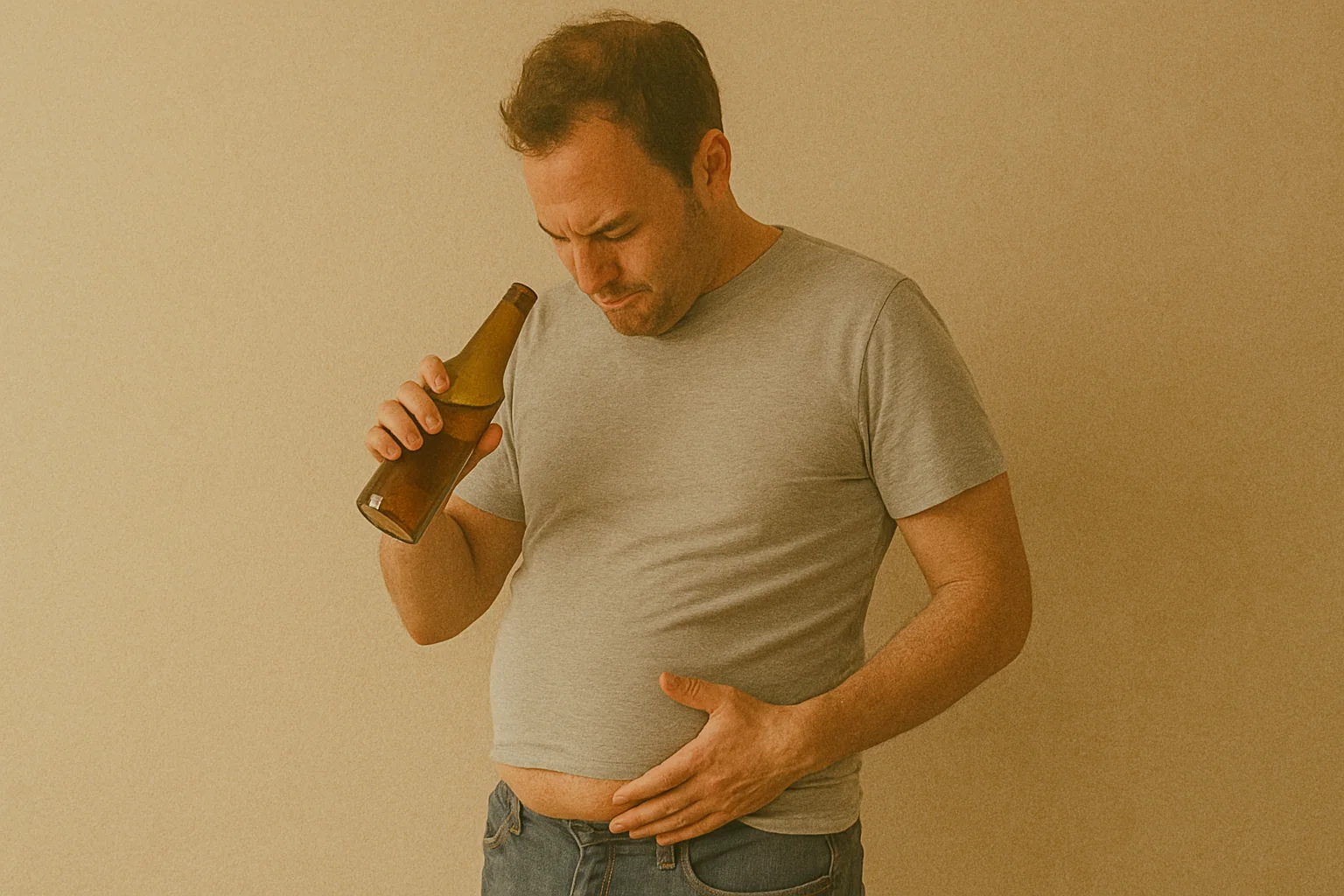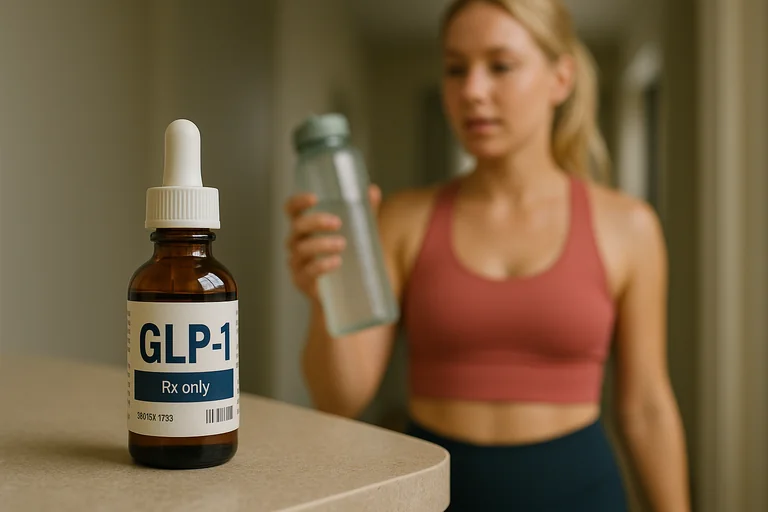A 2 minute assessment to get a personalized mental health or alcohol recovery plan.
Think that firm, round belly is just from drinking too much beer? The visceral fat accumulating around your organs is far more dangerous than you realize.
What You'll Discover:
- Why "beer belly" is misleading and any alcohol can cause dangerous abdominal fat.
- The difference between soft fat you can pinch and hard visceral fat that kills.
- How alcohol shuts down your body's fat-burning completely.
- Why that hard, protruding belly means serious health risks are already developing.
You've noticed it creeping up on you—that firm, round protrusion where your flat stomach used to be. Friends joke about your "beer belly," and you laugh along, but privately you're concerned. Is this really just about the beers you've been enjoying, or is something more serious happening to your body?
Or at least, that's what you tell yourself - that it's just a harmless beer belly everyone gets. In actuality, what's happening inside your abdomen is far more dangerous than cosmetic weight gain. That hard, protruding belly isn't just fat under your skin - it's visceral fat wrapped around your organs, releasing inflammatory compounds into your bloodstream. After all, if it was just about calories, everyone who drinks would have the same belly. But in actuality, more recent research into alcohol metabolism shows that alcohol specifically triggers visceral fat accumulation in ways that food alone doesn't.
It may be time to understand what's really happening in your abdomen if avoiding diabetes, heart disease, and liver damage is a priority.
The "Beer Belly" Myth That's Keeping You From Understanding the Real Problem
Don't let the casual nickname fool you into thinking this is just about beer or that it's harmless. The truth about alcohol belly has nothing to do with what type of alcohol you drink.
Many researchers, doctors and health experts will tell you that "beer belly" is a completely misleading term. Cleveland Clinic's Dr. Daniel Allan explains there's no evidence that beer specifically causes abdominal weight gain. Even if you only drink wine or spirits, you can develop the same dangerous abdominal fat. It's particularly concerning for people who think switching from beer to liquor will solve the problem. For example, someone switching to vodka sodas thinking they're making a healthier choice.
Now that you have a better idea that all alcohol contributes to belly fat, let's delve further into why alcohol uniquely causes this specific type of dangerous fat accumulation, some of which may be very surprising.
How Alcohol Hijacks Your Metabolism and Forces Fat Storage
The undeniable truth is that alcohol completely disrupts your body's normal fat-burning processes. There's the immediate effect while drinking, as well as the lasting metabolic damage that continues for hours or days.
Your Liver Stops Burning Fat Completely
This is one of the major metabolic disasters that happens when you drink. Your liver treats alcohol as a toxin that must be eliminated immediately. Dr. Allan explains that your liver will preferentially burn alcohol instead of fat when consumed. Research shows this metabolic hijacking causes:
- Complete shutdown of fat burning
- Forced storage of dietary fats
- Disrupted hormone production
- Increased insulin resistance
- Accumulated liver fat
The Calorie Bomb Nobody Calculates
Although alcohol's metabolic effects are bad enough, the caloric load makes everything worse. Beer calories can rival sugary sodas, but people rarely count them. But here's where it gets worse - alcohol calories provide zero nutrition while triggering appetite. The double whammy means:
- 7 calories per gram of pure alcohol
- No nutritional value whatsoever
- Increased hunger and cravings
- Poor food choices while drinking
- Late-night eating binges
The Hormonal Chaos That Follows
After drinking, your hormones remain disrupted for days. That's because alcohol affects testosterone, estrogen, cortisol, and growth hormone.
The hormonal disruption causes:
- Increased cortisol promoting belly fat
- Decreased testosterone reducing muscle
- Disrupted leptin increasing hunger
- Impaired insulin sensitivity
- Slowed metabolism overall
Worried your belly is getting harder and more protruding? That's visceral fat accumulating around your organs.
The Sleep Destruction Making Everything Worse
Many people are surprised to find that alcohol ruins sleep quality even if you fall asleep easily. It's now believed that alcohol prevents deep REM sleep because:
- It disrupts sleep cycles
- Causes frequent wakening
- Prevents restorative sleep
- Increases next-day hunger hormones
- Reduces impulse control
The Inflammation Cascade
Another serious issue with alcohol is systemic inflammation. Even if you don't feel inflamed, alcohol triggers inflammatory responses that:
- Damage gut lining
- Release inflammatory cytokines
- Increase fat storage signals
- Impair nutrient absorption
- Worsen insulin resistance
The issue of inflammation compounds over time. There are far too many people developing chronic diseases from years of "moderate" drinking, but the inflammation starts with that alcohol belly.
The Other Terrifying Truth - Visceral Fat Is Literally Killing You From Inside
The other major danger with alcohol belly is that it's not the fat you can see and pinch. You may think all fat is the same, but visceral fat wrapped around your organs is metabolically toxic.
Not all belly fat poses the same risks, but visceral fat is uniquely dangerous. Harvard's Dr. Howard LeWine explains that fat that is soft and jiggles is subcutaneous, while a hard belly indicates visceral fat. Very few people understand this distinction until they develop serious health problems. More often they assume a firm belly means they're "solid" not fat.
What might be most troubling is that visceral fat acts like an organ itself, releasing hormones and inflammatory compounds. Other health disasters visceral fat causes include dramatically increased risk of heart disease, type 2 diabetes, and certain cancers.
Why That Hard, Protruding Belly Is Your Body's Emergency Warning Signal
Now with better understanding of visceral fat dangers, that firm belly takes on new meaning. But more importantly, it indicates serious health risks are already developing.
What's most concerning about a hard alcohol belly is what it reveals about internal damage. Dr. Allan warns that a very firm beer belly indicates high visceral fat accumulation. Essentially, your organs are swimming in inflammatory fat. That is why health risks skyrocket with waist circumference.
This is obvious when you understand the anatomy, but most people don't realize the danger. The visceral fat is packed so tightly around organs it pushes the abdominal wall outward. The firmness isn't muscle - it's dangerous fat pressing from inside. It will continue accumulating until you address the alcohol consumption.
The takeaway is that a hard, protruding belly means you're already at high risk for diabetes, heart disease, and liver damage.
The good news is that visceral fat responds quickly to lifestyle changes, disappearing faster than subcutaneous fat.
The Measurement That Could Save Your Life
Clearly, waist circumference predicts health risks better than weight or BMI. But understanding the danger zones reveals when immediate action is needed.
In addition to how your belly feels, the actual measurement matters enormously. Dr. LeWine states if your waist at the navel is 40 inches or more, see your doctor immediately. For women, 35 inches indicates high risk.
Let's look at what these measurements mean practically. Imagine you've been gradually gaining abdominal weight over several years of regular drinking. Your pants size has increased, but you figure it's normal aging. Then you measure and discover you're at 42 inches - well into the danger zone. This measurement indicates significant visceral fat accumulation requiring immediate intervention.
Another key consideration is that waist size predicts disease better than any other measurement. Studies show waist circumference correlates directly with heart disease, diabetes, and early death risk. Each inch of increased waist size substantially increases health risks.
NEED TO KNOW: Measure your waist at navel level, not where your pants sit. A measurement over 40 inches (men) or 35 inches (women) means you need medical evaluation immediately.
How Alcohol Makes You Eat Like an Idiot
If you've ever wondered why you crave terrible food when drinking, there's hard science behind those late-night food disasters.
Alcohol doesn't just add calories - it fundamentally disrupts appetite regulation and food choices. Dr. Allan notes that consuming too many calories from alcohol and food leads to belly fat. But alcohol specifically triggers overeating through multiple mechanisms.
First, alcohol stimulates appetite hormones making you genuinely hungrier. Second, it impairs the prefrontal cortex that controls impulse and decisions. Third, it lowers blood sugar triggering carb cravings. Fourth, social drinking often involves high-calorie bar food. Fifth, late-night drunk eating becomes habitual.
These factors combine to create perfect conditions for weight gain. You're consuming liquid calories, eating more food, choosing worse options, and doing it late when metabolism is slowest.
The classic drunk food choices - pizza, fast food, fried foods - aren't accidents. Your alcohol-impaired brain specifically craves high-fat, high-carb combinations that promote maximum fat storage.
But here's what's critical: this pattern becomes habitual. Regular drinkers develop conditioned responses where alcohol automatically triggers overeating, creating a vicious cycle of weight gain.
Breaking Free From Alcohol Belly Before It's Too Late
The encouraging news about visceral fat is its responsiveness to change. Dr. Allan confirms that visceral fat breaks down quicker than other body fat types.
This means addressing your alcohol consumption can show rapid results. Unlike subcutaneous fat that stubbornly clings, visceral fat mobilizes quickly when you create the right conditions. Many people see significant waist reduction within weeks of reducing alcohol.
The most effective approach combines alcohol reduction with strategic lifestyle changes. Simply doing crunches won't work - you need comprehensive metabolic improvement. This means addressing alcohol intake, improving food choices, adding cardiovascular exercise, and prioritizing sleep quality.
For some people, complete alcohol elimination is necessary, especially if waist circumference is in the danger zone. Others can achieve results by significantly reducing consumption and avoiding drinking-eating combinations.
Understanding your relationship with alcohol helps determine the best approach. If you can't moderate consumption despite health risks, professional help may be needed.
Worried that hard belly is putting your health at serious risk?
If your waist measurement exceeds safe limits, if you're concerned about visceral fat accumulation, or if you can't reduce drinking despite knowing the dangers, it's time for professional help. Choose Your Horizon offers 100% online, confidential access to Naltrexone treatments that can help you reduce alcohol consumption and start reversing that dangerous belly fat.
Ready to understand how alcohol is affecting your health? Take the online Alcohol Use Assessment to evaluate your drinking patterns and explore evidence-based options for protecting your health before that alcohol belly causes irreversible damage.




